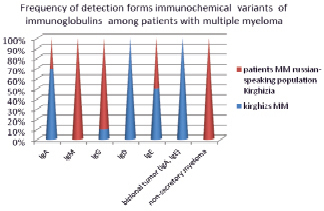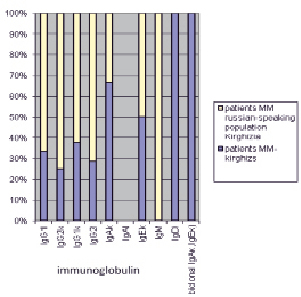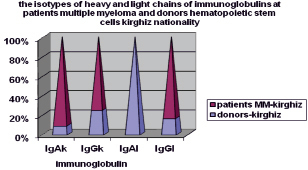The article presents the results of studies elicitation form of the immunoglobulins among patients with multiple myeloma of kirghiz nationality type of IgA in 44 % of cases, IgD in 12 % of cases, IgE in 4 % of cases, biclonal tumor (Ig A, IgE) in 4 % of cases, IgM in 0 % of cases, non-secretory myeloma in 0 % of cases and the frequently occurring form types of IgG in 36 % of cases and also detection in the form of the type IgG1λ-chain in 32 % of cases, IgG2k-chain in 26 % of cases, IgG1k-chain in 38 % of cases, IgG2λ-chain in 29 % of cases, IgAk-chain in 68 % of cases, IgAλ-chain in 0 % of cases, IgEk-chains in 50 % of cases, IgM in 0 % of cases, IgDλ – chains in 100 % of cases and biclonal tumor (IgAk, IgEk) in 100 % of cases compared with patients with multiple myeloma of the Russian-speaking population inhabitants of Kirghizia. In detail described clinical and laboratory parameters and elicitation of rare forms of immunoglobulins type Ig A-myeloma, IgE, IgD and biclonal tumor (IgA, IgE) among patients of the kirghiz nationality, where the flow of the disease is more malignant, which dictates the need for a timely approach to the choice of therapy. Elicitation, also the increased the content of free easy (k,λ)chains of immunoglobulin’s type IgAk-chain in 5 % of cases, the Ig Gk-chain in 20 % of cases, the IgGλ -chain in 15 % of cases and the IgAλ -chain in practically 100 % of cases among the kirghiz population in healthy voluntary bone marrow donors on compared with patients multiple myeloma of kirghiz nationality. When planning closely related, unrelated bone marrow transplantation, it should take account and research on according to the indications of potential bone marrow donors on content of free light chains of immunoglobulin’s in serum blood with a prophylactic purpose.
To date, the level morbidity of multiple myeloma among malignant tumors according to domestic and foreign literature is about 1 %. This tumor occurs mainly in the elderly, the average age is 68-70 years, but Last years have incline to rejuvenate the disease. In China, the prevalence morbidity of multiple myeloma is 1: 100 000 population in year [7]. The morbidity in Europe is 6 on 100 000 population in year [9]. In the multinational country as Кirghizia, the morbidity of multiple myeloma on the 6,019,000 population 4-5 patients in year and the elicitation among the kirgiz population averages 1-2 patients in year, at about 0.00001 %. One of the most frequent manifestations of the biological activity of tumor plasma cells is the production of monoclonal immunoglobulins. At disease of multiple myeloma for install an immunochemical variant is necessary investigation in the blood serum on the content of types IgA, IgM, IgG, and if necessary-IgD and IgE.
The authors of [5] in the results of the studies note that, at multiple myeloma, the immunochemical variant of the type IgAk-chain with a chronic renal failure of IIA and B -III degree and anemia, frequently with low survival.
It should be noted that, taking into account the clinical and hematological characteristics and complications of at IgA-myeloma, is necessary a timely approach to the choice of therapy and the use of auto transplantation of hematopoietic stem cells or at availability of HLA-identical donor, regardless of the age of the patient conduct the allogeneic bone marrow transplantation [4].
The works, aimed at studying studies on indications or with a prophylactic purpose on the types of heavy and the content of free easy chains of immunoglobulins in patients with multiple myeloma and bone marrow donors among different of ethnic people and nationalities, to us did not meets.
The aim of our study is to determine of frequency the elicitation and prevalence types of heavy and the content of free light (k, λ) chains of immunoglobulins in patients with multiple myeloma and among potential donors of the bone marrow of kirghiz nationality.
Materials and methods of research
The research group included of National Register of hematopoietic stem cells Kirghizia-86 voluntary donors of kirghiz nationality, typed from 2004 to June 2017 years on the types of heavy and the content free easy (k,λ)chains immunoglobulins. A total 27 women and 59 men, the ages of 18 and 50 year old, who resided temporarily in St. Petersburg, Russia. Analyzes (sera blood) research – 86 voluntary donors of hematopoietic stem cells of kirghiz nationality on the IgA, IgG, IgM, IgD, IgE, of them were tested. -8 examined in the laboratory “InterMed” and 78 donors in the laboratory of hybrid technology CNIRRI FASR, St. Petersburg the Ministry of Health of Russia. Included the materials of previously studied patients with multiple myeloma [3] and from 2004 to 2016 year were examined are included. 43 primary patients with multiple myeloma, of them (4 kirghiz nationality and 36 Russian-speaking residents of Kirghizia) in the St. Petersburg Research Institute of Epidemiology and Microbiology named after Louis Pasteur, the St. Petersburg Clinical Hospital of the Russian Academy of Sciences, the Eurasian center of oncohematology, immunology and therapy. And the total group consisted- 115 patients with different stages of the disease course, of them 24 kirghiz nationalities and 91 patients of the Russian-speaking population of Kirghizia. A total 43 women and 72 men, all citizens of the Kirghiz Republic, the age of patients ranged from 33 to 90 years. The diagnosis of multiple myeloma was based on standard criteria, including the classical triad: plasma cells in the bone marrow of at least 10 %, bone damage of varying degrees – from osteoporosis to osteolysis, monoclonal protein in the blood and /or urine. At each patient took into account clinical and laboratory indicators, immunological variants of production of immunoglobulins of heavy and light chain types [1, 2]. Patients were distributed on the stages flow by until now of the recognized system staging multiple myeloma, proposed by Durie B.G.M., Salmon S.E. [6], and the International Staging System Multiple Myeloma (ISS, 2005) [8].
In the immunology laboratory of the National Center for Cardiology and Therapy in city Bishkek, were spend studied in blood sera – 115 patients on the IgA, IgM, IgG and according to indications on the IgD, IgE. Of these 51 patients with multiple myeloma from the hematology department of the National Hospital of the Ministry of Health of the Kirghiz Republic from 1995 to November 1999 were research (blood serum) on immunoglobulins IgA, IgG, IgG1, IgG2, IgM, IgD, IgE and easy (k, λ) chains in the laboratory hybridoma technologies of CNIRRI FASR, St. Petersburg the Ministry of Health of Russia. Analyzes (blood serum) of patients with multiple myeloma were delivered by avia delivery in mini-refrigerated containers at minus 10 °.
Statistical processing of the results obtained included the analysis of standard criteria. To assess the reliability of differences in the occurrence of certain features between the control group and the MM group of patients, and donors, used λ2. Determination of the value of p corresponding to the value found. χ2 was conducted on a computer program, taking into account one degree of freedom. All mathematical calculations and general statistical analysis of the results obtained were carried out with the help of a personal computer using the application package for spreadsheets – Microsoft-Excel M version 7 for Windows 95, Windows-2010, Statistica-5, Statistica-6.
Definition immunoglobulins types of heavy and free easy chains in the serum blood
The immunoglobulins were typed methods in a direct solid-phase immune-enzyme analysis. Paraproteins were immobilized on a solid phase sera diluted 1:105 and 1: 106 on 0.1 m carbonate-bicarbonate buffers pH 9.5. Heavy chain isotypes and light chain types of myeloma immunoglobulins were determined using conjugant’s of monoclonal antibodies (MCAT) with horseradish peroxides. Typing was conducted in the laboratory of immunology at the Kirghiz Research Institute of Cardiology and Therapy in city Bishkek and in the laboratory of the hybrid technology CNIRRI FASR, St. Petersburg the Ministry of Health of Russia.
Results of research and their discussion
The results of our studies among patients with multiple myeloma of Kirghiz nationality and patients with multiple myeloma of the Russian-speaking population of Kirghizia, as can be seen from the presented fig. 1, according on the frequency of detection of immunochemical variants of immunoglobulins at the comparison showed, that among the patients of MM of kirghiz nationality immunoglobulins detection such as IgA in 64 % of cases, IgM in 0 % of cases, IgG in 8 % of cases, IgD in100 % of cases, IgE in 50 % of cases, biclonal tumor (Ig A, IgE) in 100 % of cases, non-secretory myeloma in 0 % of cases.
In patients with MM of the Russian-speaking population of Kirghizia, immunoglobulins detection such as IgA occur in 36 % of cases, IgM in 100 % of cases, IgG in 92 % of cases, IgD in 0 % of cases, IgE in 50 % of cases, biclonal tumor (Ig A, IgE) in 0 % of cases, non-secretory myeloma in 100 % of cases.
On the significance of differences between patients with multiple myeloma of kirghiz nationality and the control group on the frequency of occurrence of immunoglobulin types, there are statistically highly significant differences, p < 0.05.
At comparing the frequency of detection of immunoglobulin types in patients with MM among kirghiz nationality IgA in 44 % of cases, Ig M in 0 % of cases, IgG in 36 % of cases, IgD in 12 % of cases, IgE in 4 % of cases, biclonal tumor (Ig A, IgE) in 4 % of cases, non-secretory myeloma in 0 % of cases (fig. 2).
At the comparison are detected among patients with multiple myeloma of kirghiz nationality type IgG1λ-chain in 32 % of cases, IgG2k-chain in 26 % of cases, IgG1k-chain in 38 % of cases, IgG2λ-chain in 29 % of cases, IgAk-chain in 68 % of cases, IgAλ-chains in 0 % of cases, IgEk-chains in 50 % of cases, IgM in 0 % of cases, IgDλ-chains in 100 % of cases and biclonal tumor (IgAk, IgEk) chains in 100 % of cases. In patients with multiple myeloma of the Russian-speaking population residents of Kirghizia are recognize type IgG1λ-chains in 68 % of cases, IgG2k-chains in 74 % of cases, IgG1k-chains in 62 % of cases, IgG2λ- chains in 71 % of cases, IgAk-chains in 32 % of cases, IgAλ -chains in 0 % of cases, IgEk-chains in 50 % of cases, IgM in 100 % of cases, IgDλ-chains in 0 % of cases and biclonal tumor (IgAk, IgEk) chains in 0 % of cases (fig. 3).
It is shown in fig. 4, that in patients with multiple myeloma of kirghiz nationality there is a variant of IgAk-chain type in 95 % of cases, IgGk-chains in 80 % of cases, IgGl-chains in 85 % of cases and no detection IgAl-chain. In compared to potential donors of hematopoietic stem cells of kirghiz nationality, who considered themselves to be practically healthy people, but when studying by the indications on content of free light chains of immunoglobulins in serum blood, where IgAk-chains were detected in 5 % of cases, IgGk-chains in 20 % of cases, IgG-lchains in15 % and IgAλ-chains in almost 100 % of cases.
Thus, and in healthy kirghiz donors, at prophylactic studies were detected high titers of IgA, IgG with increased k and λ-chains.
Conclusion
The immunochemical variant is of no small importance and the revealed high titres of the heavy types and the content of free light chains of immunoglobulins are one of the diagnostic criteria at multiple myeloma. In terms of prevalence, the incidence of multiple myeloma is less common among kirghiz nationality on the compared with patients with multiple myeloma of the Russian-speaking population of Kirghizia. At our observation among patients with MM of kirghiz nationality at the primary staging diagnosis the elevated titers of rare forms of immunoglobulins were more often recorded as IgAk-chains, less IgD λ- chains, IgEk-chains and biclonal tumor (IgAk,IgEk). It should be noted that among potential donors of the bone marrow of the kirghiz nationality, at prophylactic studies, can be found high titers IgA, IgG with increased k-λ chains.

Fig. 1. Comparative the characteristics of spread of immunochemical variants immunoglobulins among patients multiple myeloma inhabitant Kirghizia

Fig. 2. Frequency of detectability types of immunoglobulin’s at patients with multiple myeloma among kirghiz nationality

Fig. 3. Comparative characteristics of isotypes heavy and light (k, ?) chains of immunoglobulins among patients with multiple myeloma of kirghiz nationality and Russian-speaking population of Kirghizia

Fig. 4. Frequency the detection among kirghiz nationality of isotypes heavy and the content of free easy chains (k,?) immunoglobulins in patients with multiple myeloma and donors of hematopoietic stem cells
However, in occasion coincidence bone marrow donor on the all significative of the studies and including immunogenetic indices of the main histocompatibility complex of the HLA-A*,B *, C*, DRB1 *, DQB1 * system, but if the donor has elevated titers on the content of free light chains of immunoglobulins, it is necessary to eliminate the donor from bone marrow donation. In this connection, in order to obtain good results in the post transplant period, the have important value of qualitative selection of the bone marrow donor is importance. Search in the assortment of donors should be carried out by the immunosecelektive method, preferably where the patient before lived and now resides, and to study modern features of the state of health of donors. Voluntary bone marrow donors, according to testimony, should be examined before inclusion in the National Registry of hematopoietic stem cells and before bone marrow sampling on of heavy and the content of free light chains the immunoglobulins with a prophylactic purpose.
The work is submitted to the International Scientific Conference “Fundamental and applied research in medicine”, France (Paris), 19 to 26 Oct, 2017, came to the editorial office оn 07.09.2017.

